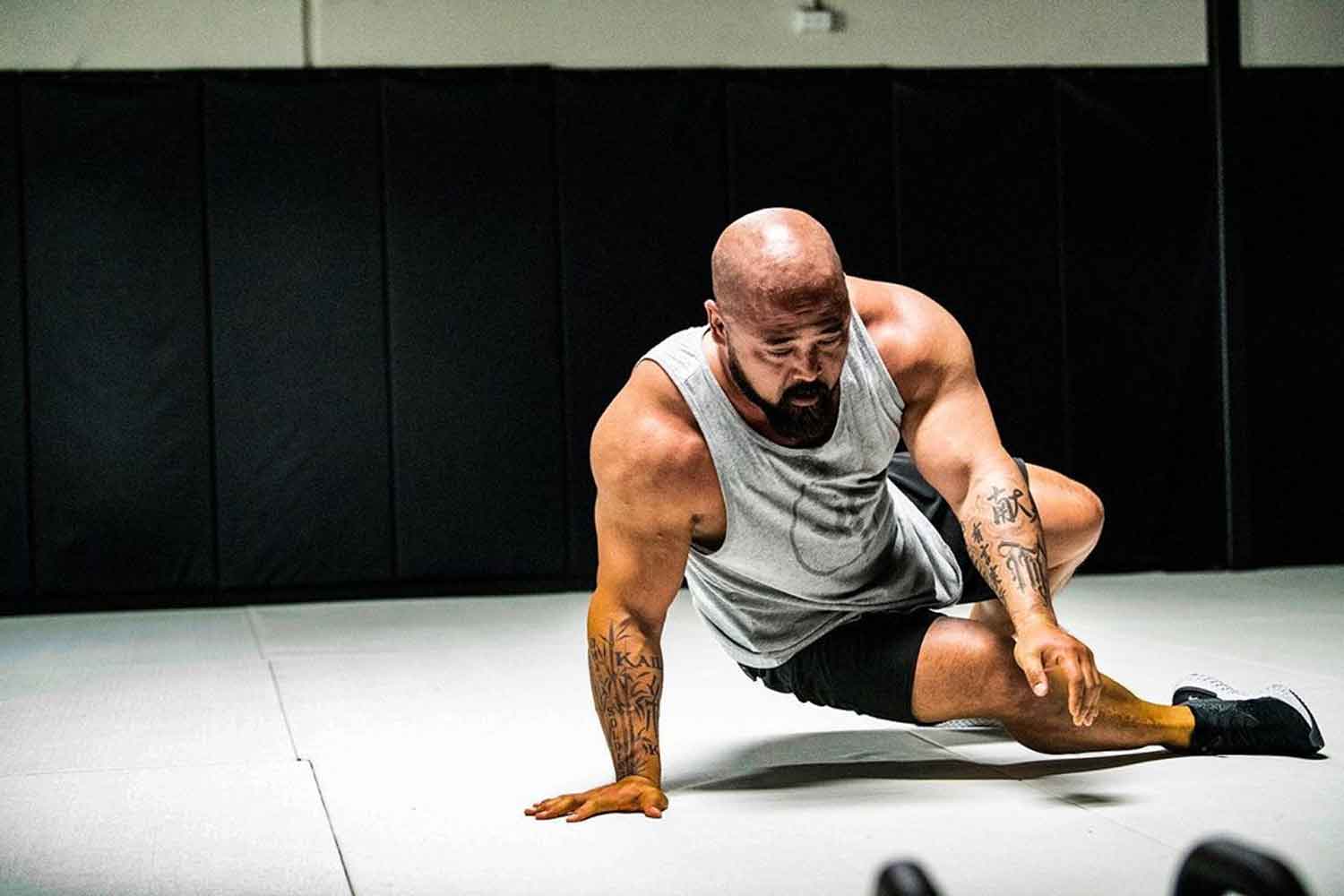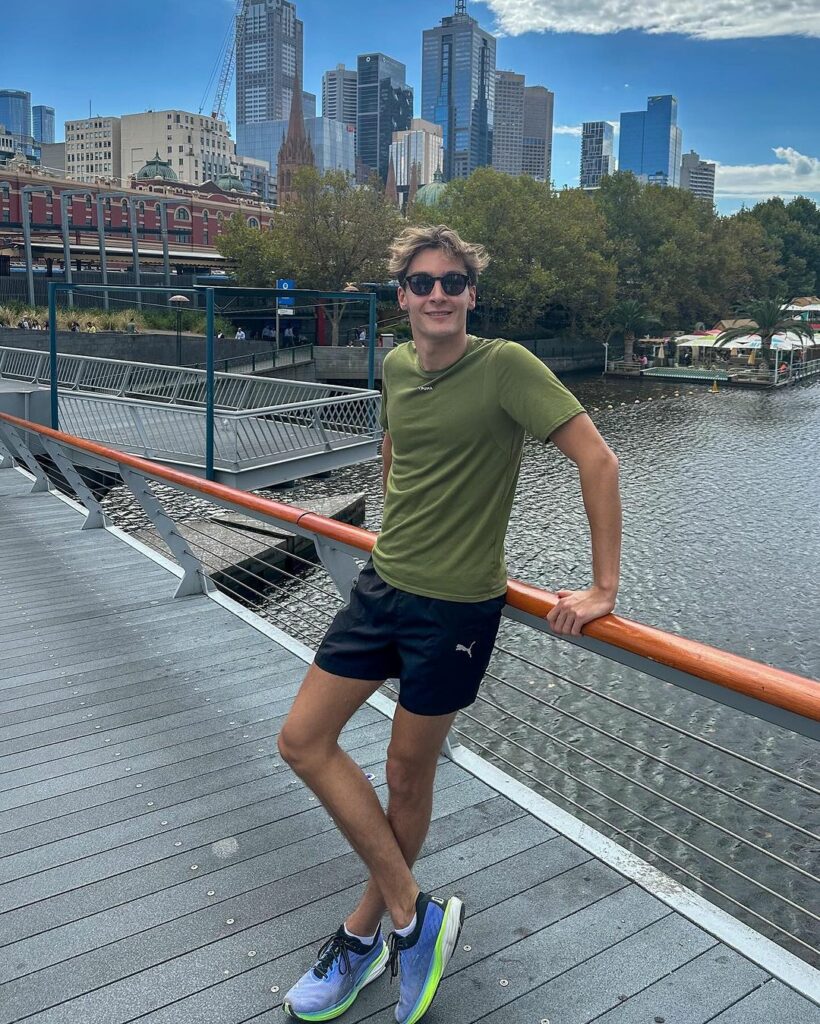
Da Rulk, aka Joseph Sakoda, is a Hawaiian man mountain with an original take on fitness. And we’ll get to that. But first there’s the matter of “Da Rulk”. Origin story, please.
“Rulk came from some of my Brazilian friends,” says Rulk on a recent trip to Sydney. “They used to call me “Hulk” because of my strength. But in Portuguese the ‘H’ sound is spelled with an ‘R’, so that’s why it’s Rulk.”
Rulk it is. Truth be told, though, the sobriquet is a tad misleading. Because Rulk is one of the friendliest men I’ve ever met. He radiates energy – though not the kind that busts down doors and upturns cars. It’s pure feel-good: he makes every single person on set feel as though this is their moment. He’s also meticulous: all his athletic gear is perfectly folded and packed.
Rulk is one of the trainers behind Centr, the health and fitness app that puts Chris Hemsworth’s team in the palm of your hand. But his day job is training some of the most hardened real-life heroes across the world: first responders.
His signature is Raw Functional Training (RFT), which is less a standalone training system than an adjunct of oft-overlooked work based on primal movements. After all, there’s no machine in the gym that can mimic the act of crawling through a burning building to rescue a victim. Here’s Rulk’s story. In Rulk’s own words.
“You need to know a little about my background. I played American football. Then I did judo for a long time. I’m a proponent of many forms of training: strength training, power training… they’re all great. But I was always fascinated with bodyweight training.
My approach is to train not just for aesthetics. So many guys do. They figure, ‘If I look better, I feel better’. I think that’s okay. But there are days when we just don’t look the way we want to.
My whole thing is: what if we trained you to be empowered? To be mentally and physically stronger. And to learn the habit of consistently doing the work. I think that if we’re mentally strong we can endure far more than if we’re just fit.
So, first responders: there would be firefighters and police officers who were extremely fit. They were jacked and they were conditioned. But they would go into a fire and they wouldn’t perform well. And no one understood why.
When I was designing my curriculum for RFT, I was drawn to sequencing and movement patterns. By that I mean, how quickly can you adapt to different scenarios? How efficient and fast are you at processing information? I can tell you this: incorporating RFT into the training of our first responders has been transformative to their performance.
RFT focuses on the sequence of how our bodies take in information during performance. For example, how our senses react to light, sound and temperature, and how we process that information. This can be applied to whoever I train because, in life, we don’t just walk. We run. We jog. We crawl. We sit. The better your body adapts to all these requirements, the more efficiently you move and the less pain you experience.
MOVE LIKE A KID
If you’re a firefighter, police officer or military, they don’t really want you to be huge. They want you to be strong and fit. But also able to adapt. And mentally strong.
A lot of the things that you see me do – long cycle-work or crawling for five kilometres – are challenging me physically and mentally. Anyone can crawl. It’s a primary movement pattern. Babies crawl to get strong enough to sit up. But can you do it for a long time? As they say, you take the highest-level athlete and have him follow around a toddler for a day. By day’s end, the toddler’s fine and the athlete’s exhausted.
I like two aspects of training this way. The physiological side, which is: let’s see what part of your body breaks down first. And, can you push yourself to finish the task? Really push because you want to challenge yourself? Because if you can, I see the crossover to real life when we’re facing stress in our relationships and work.
My advice with RFT is to adopt it as either a standalone program or as an enhancement. Whatever training you’re doing now, keep doing it if you think it’s working. But to take your movement efficiency and performance to a new level, introduce RFT into your training. I think you’ll see the benefits.
We focus so much on getting strong physically, but that means nothing if you’re not strong mentally. With RFT there’s a lot of progressions and regressions that you can use depending on whether you’re carrying injuries or restrictions, like muscular tightness.
I think the fitness industry is in a state of flux. Guys are looking less at trying to get smashed and more at trying to make improvements that actually benefit their lives. Because most guys don’t want to be a Navy SEAL or a firefighter. They may like the fact they can train like one. But they just want to be able to play with their kids, be active with their spouse or go on a run.
WHY TRAIN?
For me, it’s not a matter of how hard you train. It’s, can you train consistently? And, how well do you move? RFT removes common barriers to training. Don’t have much space? That’s okay. You could do RFT in your living room or at the beach. Time poor? Also okay. An RFT session can take five minutes, 30 minutes or longer. Once you take out the excuses you can get more consistent with things. And we’re habitual by nature.
I first met Chris when he was developing Centr. He reached out to me to see if I wanted to jump onboard, and immediately we were like brothers. Chris wants to help as many people as he can. He’s a great guy.
There are some people who just want to train for aesthetics. And if that’s what you want to do, fantastic. It’s great and admirable. But I’m much more about the translation of training practices to real life. How is what you’re doing going to make you a stronger person? You’re only in the gym for a couple of hours a day, so shouldn’t those two hours benefit you mentally?
A lot of guys use the gym as a form of stress relief. I get it. But what if it could also make you more resilient? That will then carry over to your everyday life. If you’re focused on overcoming obstacles and doing that every day, it’s easier to accomplish other things because it becomes your habit.
I see a shift in the fitness industry. The focus used to be on lifting hard and heavy. But now it’s much more about training functionally, getting the most out of your workouts and ensuring you follow a recovery protocol to avoid injury.
I think people want to be healthy, injury-free and moving towards being mentally stronger. I think that’s where the true power is: understanding and coming to grips with who you are and what you’re about. That’s the real fitness journey. Focus on the journey, not the destination. And sometimes you’ve just got to start moving on the journey to find out where you want to go.”


















